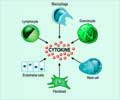Harvard Medical School (HMS) researchers have mapped out the way immune system in mouse models responds to germs in the genital tract during the initial stage of Chlamydia trachomatis infection.
Harvard Medical School (HMS) researchers have mapped out the way immune system in mouse models responds to germs in the genital tract during the initial stage of Chlamydia trachomatis infection. The study is published in the July 24 early edition online of the Proceedings of the National Academy of Sciences and could prove important in the development of vaccine against the disease.
"Right now Chlamydia is sensitive to treatment with antibiotics, but the problem is that many people have 'silent' infections that remain untreated," said researcher Michael Starnbach, PhD, HMS associate professor of microbiology and molecular genetics. "These undiagnosed infections over time lead to complications like tubal pregnancy and infertility. The goal would be to vaccinate young people to keep them from suffering from undiagnosed infection and the bad outcomes associated with it."Most pathogens (disease-causing bacteria or viruses) enter a host by penetrating mucosal surfaces such as the lung, intestine, or genito-urinary tract. The prevalence of sexually transmitted diseases has prompted studies to understand how infection is established in the genital tract and how pathogens are cleared from this site. Before Starnbach's study, however, it had not been possible to monitor invader-specific T cell (fighter cell) responses to initial infection in reproductive tissue, despite the recognized importance of T cells in controlling a number of genital pathogens
"Humans and mice have an enormous variety of T cells that are prepared to respond to pathogens – even pathogens to which they have never been exposed," Starnbach said. "Yet prior to infection, the number of T cells specific for any single pathogen is extremely low. The number is so low that it is impossible to track and monitor the activity of these T cells during their first encounter with the microbe."
To circumvent the problem, Starnbach and colleagues in the HMS Department of Microbiology and Molecular Genetics identified one of the Chlamydia proteins recognized by T cells during infection and engineered mice where all the T cells in the mice exclusively respond to this Chlamydia protein. These mice are known as T cell receptor transgenic (TCRtg) mice and have none of the T cell diversity found in a normal mouse. Starnbach and his team harvested T cells from the Chlamydia-specific TCRtg mice, labeled them with a dye, and injected them into normal mice. By boosting the number of Chlamydia-specific T cells in the recipient mice, they were able to identify and monitor them as they responded to infection.
"We found that when the recipient mice were infected with Chlamydia, the labeled T cells became activated specifically in the lymph nodes near the reproductive tract, expanded in number in those lymph nodes, and migrated into the mucosa lining the genital tract," Starnbach said. "We also found that the T cells recruited to the genital mucosa secrete gamma interferon as they respond to Chlamydia infection. Gamma interferon secretion has been described as the key molecule T cells use to rid the body of Chlamydia."
The findings show how T cell responses can be studied in reproductive tissues, which is likely to reveal avenues to the development of vaccines against Chlamydia, and possibly other STDs.
Advertisement
The goal of vaccines is to stimulate a response that mimics exposure to a pathogen, without the risks of actual infection. When a vaccine successfully accomplishes this, protection against future infection results.
Advertisement
[email protected]
617-432-0442
Harvard Medical School
Source: Eurekalert










